Simulation of Potassium Availability in the Application of Biochar in Agricultural Soil
Abstract
:1. Introduction
2. Methodology
2.1. Water Flow in the Unsaturated Soil Zone
2.2. Mass Transport and Geochemical Processes
2.3. Application of Biochar in the Soil
2.4. Coupling Water Flow, Mass Transport and Geochemical Processes
3. Results
3.1. Time Step and Spatial Discretisation
3.2. Equilibrium Exchange Approach under Saturated/Unsaturated Conditions
3.3. Kinetic Exchange Approach under Saturated/Unsaturated Conditions
4. Discussion
5. Conclusions
Supplementary Materials
Author Contributions
Funding
Institutional Review Board Statement
Informed Consent Statement
Data Availability Statement
Acknowledgments
Conflicts of Interest
References
- Stewart, W.M.; Dibb, D.W.; Johnston, A.E.; Smyth, T.J. The contribution of commercial fertilizer nutrients to food production. Agron. J. 2005, 97, 1–6. [Google Scholar] [CrossRef] [Green Version]
- Ayoub, A.T. Fertilizers and the environment. Nutr. Cycl. Agroecosystems 1999, 5, 221–226. [Google Scholar] [CrossRef]
- Dybowski, D.; Dzierzbicka-Glowacka, L.A.; Pietrzak, S.; Juszkowska, D.; Puszkarczuk, T. Estimation of nitrogen leaching load from agricultural fields in the Puck Commune with an interactive calculator. PeerJ 2020, 8, e8899. [Google Scholar] [CrossRef] [Green Version]
- Craswell, E. Fertilizers and nitrate pollution of surface and ground water: An increasingly pervasive global problem. SN Appl. Sci. 2021, 3, 518. [Google Scholar] [CrossRef]
- Bennet, E.M.; Carpenter, S.R.; Caraco, N.F. Human Impact on Erodable Phosphorus and Eutrophication: A Global Perspective: Increasing accumulation of phosphorus in soil threatens rivers, lakes, and coastal oceans with eutrophication. Bioscience 2001, 51, 227–234. [Google Scholar] [CrossRef]
- Goulding, K.W.T.; Murrell, T.S.; Mikkelsen, R.; Rosolem, C.A.; Johnston, J.; Wang, H.Y.; Alfaro, M.A. Outputs: Potassium Losses from Agricultural Systems. Improving Potassium Recommendations for Agricultural Crops. In Improving Potassium Recommendations for Agricultural Crops; Murrell, T.S., Mikkelsen, R.L., Sulewski, G., Norton, R., Thompson, M.L., Eds.; Springer Nature Switzerland AG: Norcross, GA, USA, 2021; pp. 75–97. ISBN 978-3-030-59196-0. [Google Scholar]
- Rashid, M.; Hussain, Q.; Khan, K.S.; Alwabel, M.I.; Hayat, R.; Akmal, M.; Ijaz, S.S.; Alvi, S. Obaid-ur-Rehman Carbon-Based Slow-Release Fertilizers for Efficient Nutrient Management: Synthesis, Applications, and Future Research Needs. J. Soil Sci. Plant Nutr. 2021, 21, 1144–1169. [Google Scholar] [CrossRef]
- Torabian, S.; Qin, R.; Noulas, C.; Lu, Y.; Wang, G. Biochar: An organic amendment to crops and an environmental solution. AIMS Agric. Food 2021, 6, 401–415. [Google Scholar] [CrossRef]
- Gwenzi, W.; Nyambishi, T.J.; Chaukura, N.; Mapope, N. Synthesis and nutrient release patterns of a biochar-based N–P–K slow-release fertilizer. Int. J. Environ. Sci. Technol. 2018, 15, 405–414. [Google Scholar] [CrossRef]
- Allohverdi, T.; Kumar Mohanty, A.; Roy, P.; Misra, M.; Ibáñez, E.; Antoniotti, S. Molecules A Review on Current Status of Biochar Uses in Agriculture A Review on Current Status of Biochar Uses in Agriculture. Molecules 2021, 26, 5584. [Google Scholar] [CrossRef]
- Oni, B.A.; Oziegbe, O.; Olawole, O.O. Significance of biochar application to the environment and economy. Ann. Agric. Sci. 2019, 64, 222–236. [Google Scholar] [CrossRef]
- Lehmann, J. Biological carbon sequestration must and can be a win-win approach an editorial comment. Clim. Chang. 2009, 97, 459–463. [Google Scholar] [CrossRef]
- Bilias, F.; Kalderis, D.; Richardson, C.; Barbayiannis, N.; Gasparatos, D. Biochar application as a soil potassium management strategy: A review. Sci. Total Environ. 2023, 858, 159782. [Google Scholar] [CrossRef]
- Yeh, G.T.; Cheng, H.P. A 3-Dimensional Model of Density-Dependent Subsurface Flow and Thermal Multispecies-Multicomponent HYDROGEOCHEMical Transport Project Summary (EPA/600/SR-98/159); U.S. Environmental Protection Agency: Washington, DC, USA, 1999. [Google Scholar]
- Jacques, D.; Šimůnek, J.; Mallants, D.; van Genuchten, M.T. Modelling coupled water flow, solute transport and geochemical reactions affecting heavy metal migration in a podzol soil. Geoderma 2008, 145, 449–461. [Google Scholar] [CrossRef]
- Jacques, D.; Simunek, J. User Manual of the Multicomponent Variably-Saturated Flow and Transport Model HP1; Belgian Nuclear Research Centre: Mol, Belgium, 2005. [Google Scholar]
- Wissmeier, L.; Barry, D.A. Implementation of variably saturated flow into PHREEQC for the simulation of biogeochemical reactions in the vadose zone. Environ. Model. Softw. 2010, 25, 526–538. [Google Scholar] [CrossRef]
- Xu, T.; Sonnenthal, E.; Spycher, N.; Zhang, G.; Zheng, L.; Pruess, K. Toughreact: A simulation program for subsurface reactive chemical transport under non-isothermal multiphase flow conditions. In Groundwater Reactive Transport Models; Zhang, F., Yeh, G.T., Parker, J.C., Eds.; Bentham eBooks: Soest, The Netherlands, 2012; pp. 74–95. ISBN 978-160805525-8. [Google Scholar]
- Jacques, D.; Simunek, J.; Mallants, D.; Van Genuchten, M.T. The HPx software for multicomponent reactive transport during variably-saturated flow: Recent developments and applications. J. Hydrol. Hydromech. 2018, 66, 211–226. [Google Scholar] [CrossRef] [Green Version]
- Jacques, D.; Simunek, J.; Mallants, D.; Genuchten, M.T. Modeling Coupled Hydrologic and Chemical Processes: Long-Term Uranium Transport following Phosphorus Fertilization. Vadose Zo. J. 2008, 7, 698–711. [Google Scholar] [CrossRef] [Green Version]
- Leterme, B.; Blanc, P.; Jacques, D. A reactive transport model for mercury fate in soil—Application to different anthropogenic pollution sources. Environ. Sci. Pollut. Res. Int. 2014, 21, 12279–12293. [Google Scholar] [CrossRef]
- Gai, K.; Hoelen, T.P.; Hsu-Kim, H.; Lowry, G.V. Mobility of Four Common Mercury Species in Model and Natural Unsaturated Soils. Environ. Sci. Technol. 2016, 50, 3342–3351. [Google Scholar] [CrossRef]
- Angst, T.E.; Sohi, S.P. Establishing release dynamics for plant nutrients from biochar. GCB Bioenergy 2013, 5, 221–226. [Google Scholar] [CrossRef]
- Gaskin, J.W.; Speir, R.A.; Harris, K.; Das, K.C.; Lee, R.D.; Morris, L.A.; Fisher, D.S. Effect of Peanut Hull and Pine Chip Biochar on Soil Nutrients, Corn Nutrient Status, and Yield. Soil Qual. Fertil. 2010, 102, 623–633. [Google Scholar] [CrossRef] [Green Version]
- Van Poucke, R.; Meers, E.; Tack, F.M.G. Leaching behavior of Cd, Zn and nutrients (K, P, S) from a contaminated soil as affected by amendment with biochar. Chemosphere 2020, 245, 125561. [Google Scholar] [CrossRef] [PubMed]
- Kypritidou, Z.; Doulgeris, C.; Tziritis, E.; Kinigopoulou, V.; Jellali, S.; Jeguirim, M. Geochemical Modelling of Inorganic Nutrients Leaching from an Agricultural Soil Amended with Olive-Mill Waste Biochar. Agronomy 2022, 12, 480. [Google Scholar] [CrossRef]
- Genuchten, M.T. van A Closed-form Equation for Predicting the Hydraulic Conductivity of Unsaturated Soils. Soil Sci. Soc. Am. J. 1980, 44, 892–898. [Google Scholar] [CrossRef] [Green Version]
- Mualem, Y. A new model for predicting the hydraulic conductivity of unsaturated porous media. Water Resour. Res. 1976, 12, 513–522. [Google Scholar] [CrossRef] [Green Version]
- Parkhurst, B.D.L.; Appelo, C.A.J. User’s Guide To PHREEQC (version 2)—A Computer Program for Speciation, and Inverse Geochemical Calculations. Exch. Organ. Behav. Teach. J. 1999, 312, 4259. [Google Scholar]
- Gaines, G.L.; Thomas, H.C. Adsorption studies on clay minerals. II. A formulation of the thermodynamics of exchange adsorption. J. Chem. Phys. 1953, 21, 714–718. [Google Scholar] [CrossRef]
- Appelo, C.A.J.; Postma, D. Geochemistry, Groundwater and Pollution (Fifth); CRC Press: Boca Raton, FL, USA, 2005. [Google Scholar]
- Tiruta-Barna, L. Using PHREEQC for modelling and simulation of dynamic leaching tests and scenarios. J. Hazard. Mater. 2008, 157, 525–533. [Google Scholar] [CrossRef]
- Ghorbani, M.; Amirahmadi, E.; Neugschwandtner, R.W.; Konvalina, P.; Kopecký, M.; Moudrý, J.; Perná, K.; Murindangabo, Y.T. The impact of pyrolysis temperature on biochar properties and its effects on soil hydrological properties. Sustainability 2022, 14, 14722. [Google Scholar] [CrossRef]
- Tamoši, A.; Chouchène, A.; Valatkevičius, P.; Aikas, M.; Uscila, R.; Ghorbel, M.; Jeguirim, M. The Potential of Thermal Plasma Gasification of Olive Pomace Charcoal. Energies 2017, 10, 710. [Google Scholar] [CrossRef] [Green Version]
- Schaap, M.G.; Leij, F.J.; Van Genuchten, M.T. rosetta: A computer program for estimating soil hydraulic parameters with hierarchical pedotransfer functions. J. Hydrol. 2001, 251, 163–176. [Google Scholar] [CrossRef]
- Wang, M.; Xu, D.; Bai, Y.; Yu, G.; Zhang, J.; Zhang, S.; Xu, J.; Zhang, H.; Zhang, S.; Wei, J. Dynamic Investigation on Potassium Migration and Transformation during Biochar Combustion and Its Correlation with Combustion Reactivity. Fuel 2023, 340, 127540. [Google Scholar] [CrossRef]
- Nguyen, A.T.Q.; Bui, T.A.; Mai, N.T.; Tran, H.T.; Tran, S.V.; Nguyen, N.H.; Tsubota, T.; Shinogi, Y.; Dultz, S.; Nguyen, M.N. Release Kinetics of Potassium from Silica-Rich Fern-Derived Biochars. Agron. J. 2020, 112, 1713–1725. [Google Scholar] [CrossRef]
- Wang, L.; Xue, C.; Nie, X.; Liu, Y.; Chen, F. Effects of biochar application on soil potassium dynamics and crop uptake. J. Plant Nutr. Soil Sci. 2018, 181, 635–643. [Google Scholar] [CrossRef]
- Wang, J.; Xiong, Z.; Kuzyakov, Y. Biochar Stability in Soil: Meta-Analysis of Decomposition and Priming Effects. GCB Bioenergy 2016, 8, 512–523. [Google Scholar] [CrossRef] [Green Version]
- Limwikran, T.; Kheoruenromne, I.; Suddhiprakarn, A.; Prakongkep, N.; Gilkes, R.J. Dissolution of K, Ca, and P from biochar grains in tropical soils. Geoderma 2018, 312, 139–150. [Google Scholar] [CrossRef]
- Major, J.; Rondon, M.; Molina, D.; Riha, S.J.; Lehmann, J. Nutrient Leaching in a Colombian Savanna Oxisol Amended with Biochar. J. Environ. Qual. 2012, 41, 1076–1086. [Google Scholar] [CrossRef]
- Kolahchi, Z.; Jalali, M. Simulating leaching of potassium in a sandy soil using simple and complex models. Agric. Water Manag. 2006, 85, 85–94. [Google Scholar] [CrossRef]
- Kolahchi, Z.; Jalali, M. Effect of water quality on the leaching of potassium from sandy soil. J. Arid Environ. 2007, 68, 624–639. [Google Scholar] [CrossRef]
- Bakshi, S.; He, Z.L.; Harris, W.G. Biochar Amendment Affects Leaching Potential of Copper and Nutrient Release Behavior in Contaminated Sandy Soils. J. Environ. Qual. 2014, 43, 1894–1902. [Google Scholar] [CrossRef]
- Adebayo, A.G.; Akintoye, H.A.; Shokalu, A.O.; Olatunji, M.T. Soil chemical properties and growth response of Moringa oleifera to different sources and rates of organic and NPK fertilizers. Int. J. Recycl. Org. Waste Agric. 2017, 6, 281–287. [Google Scholar] [CrossRef] [Green Version]
- Soremi, A.O.; Adetunji, M.T.; Azeez, J.O.; Adejuyigbe, C.O.; Bodunde, J.G. Effects of soil amendment on potassium fractions of Southwestern Nigerian soil. Commun. Soil Sci. Plant Anal. 2018, 10, 1186–1198. [Google Scholar] [CrossRef]
- Abd El-Mageed, T.A.; Semida, W.M. Organo mineral fertilizer can mitigate water stress for cucumber production (Cucumis sativus L.). Agric. Water Manag. 2015, 159, 1–10. [Google Scholar] [CrossRef]
- Fachini, J.; Figueiredo, C.C.; de Vale, A.T. do Assessing potassium release in natural silica sand from novel K-enriched sewage sludge biochar fertilizers. J. Environ. Manag. 2022, 314, 115080. [Google Scholar] [CrossRef] [PubMed]
- Shin, J.D.; Park, S.W.; Lee, S. Optimum Method Uploaded Nutrient Solution for Blended Biochar Pellet with Application of Nutrient Releasing Model as Slow Release Fertilizer. Appl. Sci. 2019, 9, 1899. [Google Scholar] [CrossRef] [Green Version]
- Pogorzelski, D.; Filho, J.F.L.; Matias, P.C.; Santos, W.O.; Vergütz, L.; Melo, L.C.A. Biochar as composite of phosphate fertilizer: Characterization and agronomic effectiveness. Sci. Total Environ. 2020, 743, 140604. [Google Scholar] [CrossRef]
- Luo, W.; Qian, L.; Liu, W.; Zhang, X.; Wang, Q.; Jiang, H.; Cheng, B.; Ma, H.; Wu, Z. A potential Mg-enriched biochar fertilizer: Excellent slow-release performance and release mechanism of nutrients. Sci. Total Environ. 2021, 768, 144454. [Google Scholar] [CrossRef]
- Pokharel, R.; Comer, B. Economics of Biochar. Available online: https://www.canr.msu.edu/news/economics-of-biochar (accessed on 7 March 2023).
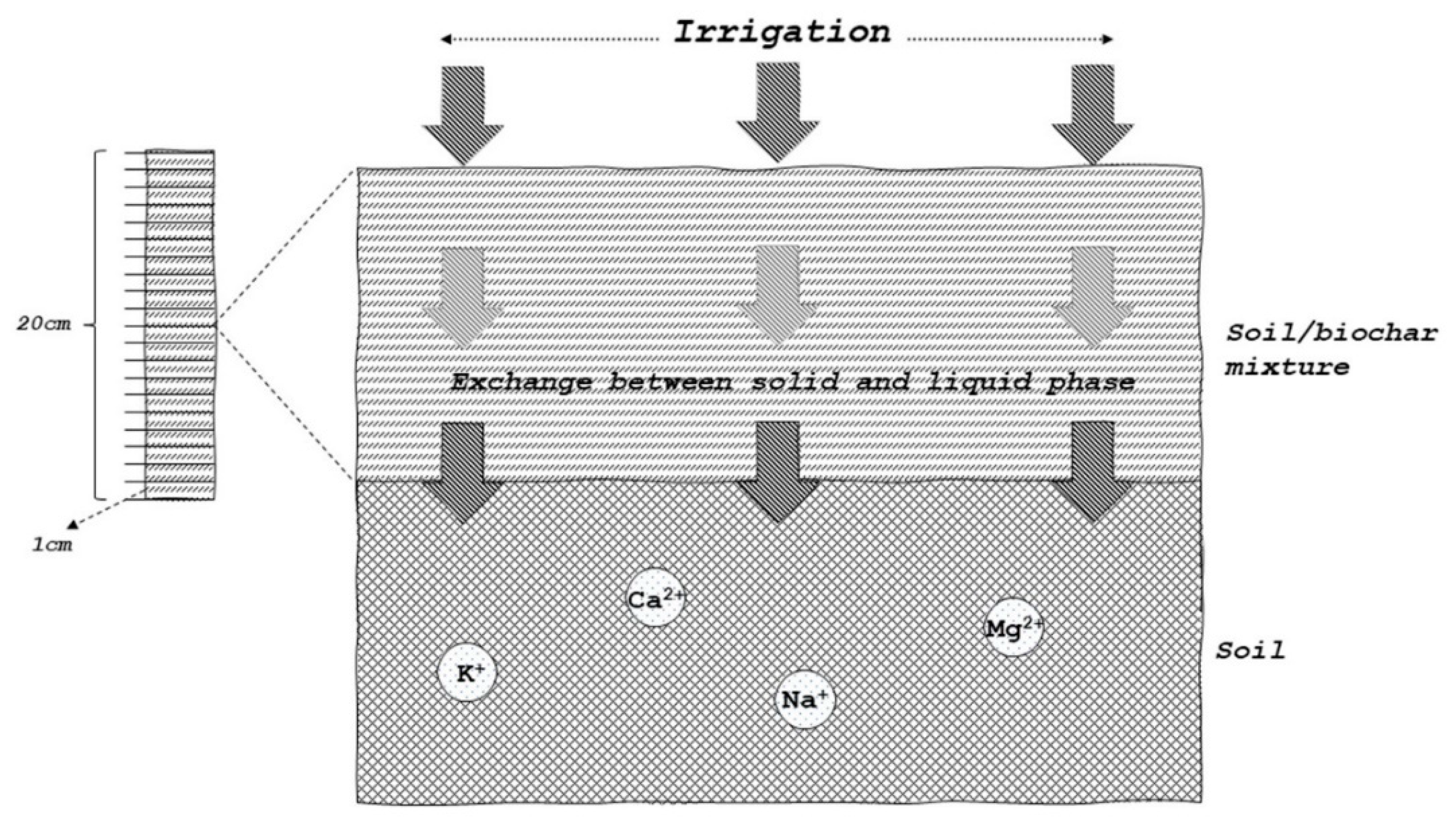

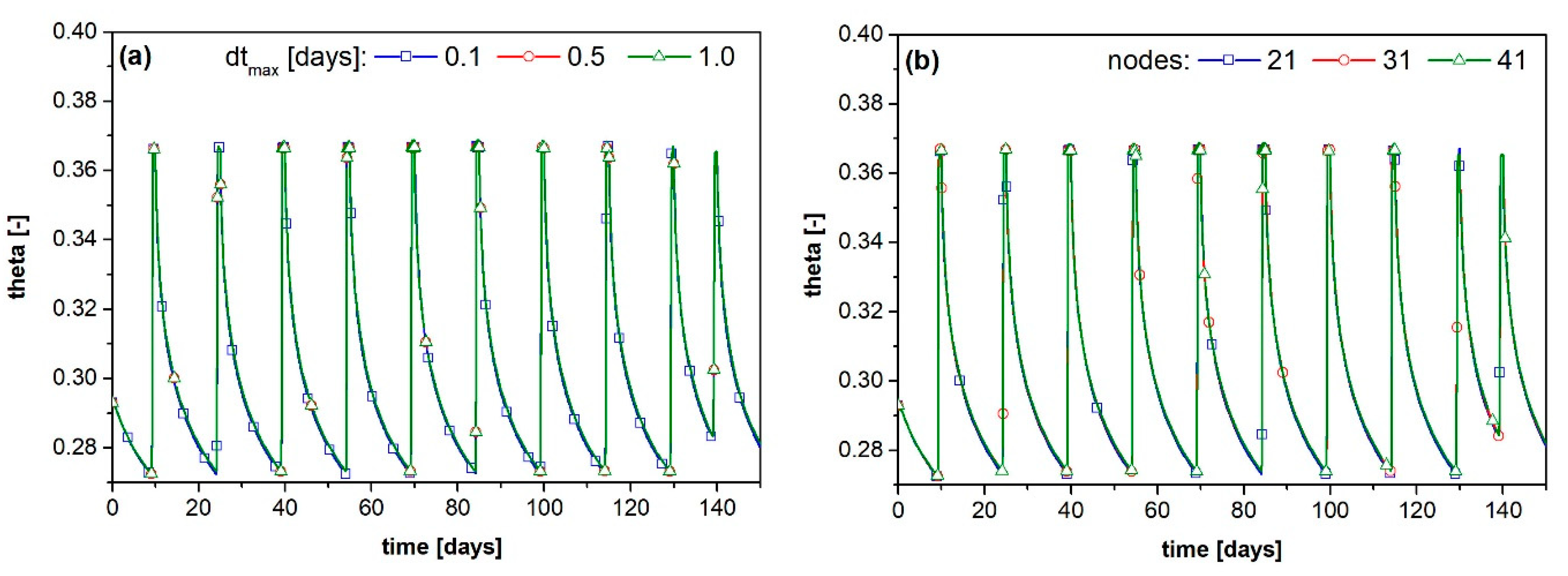

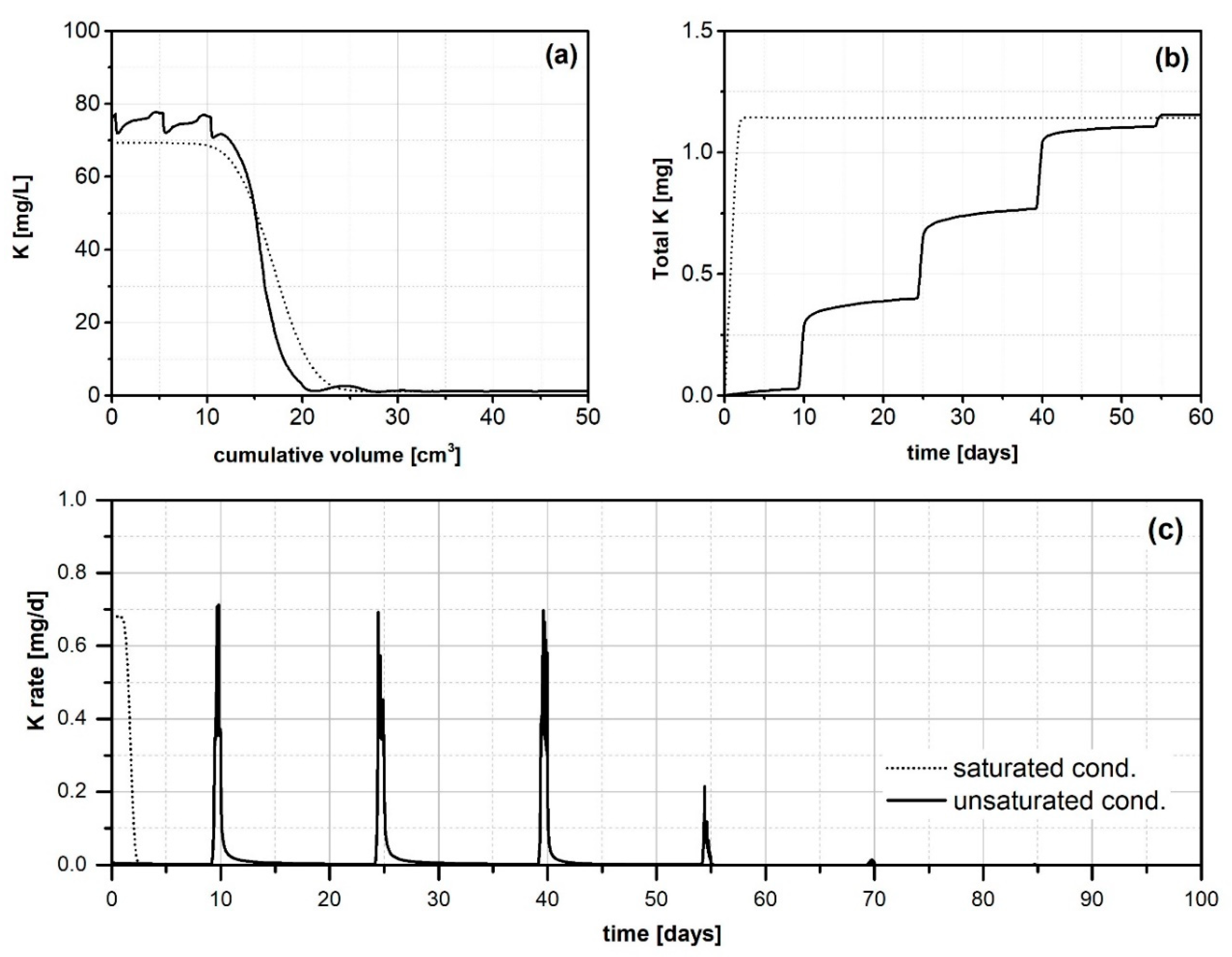
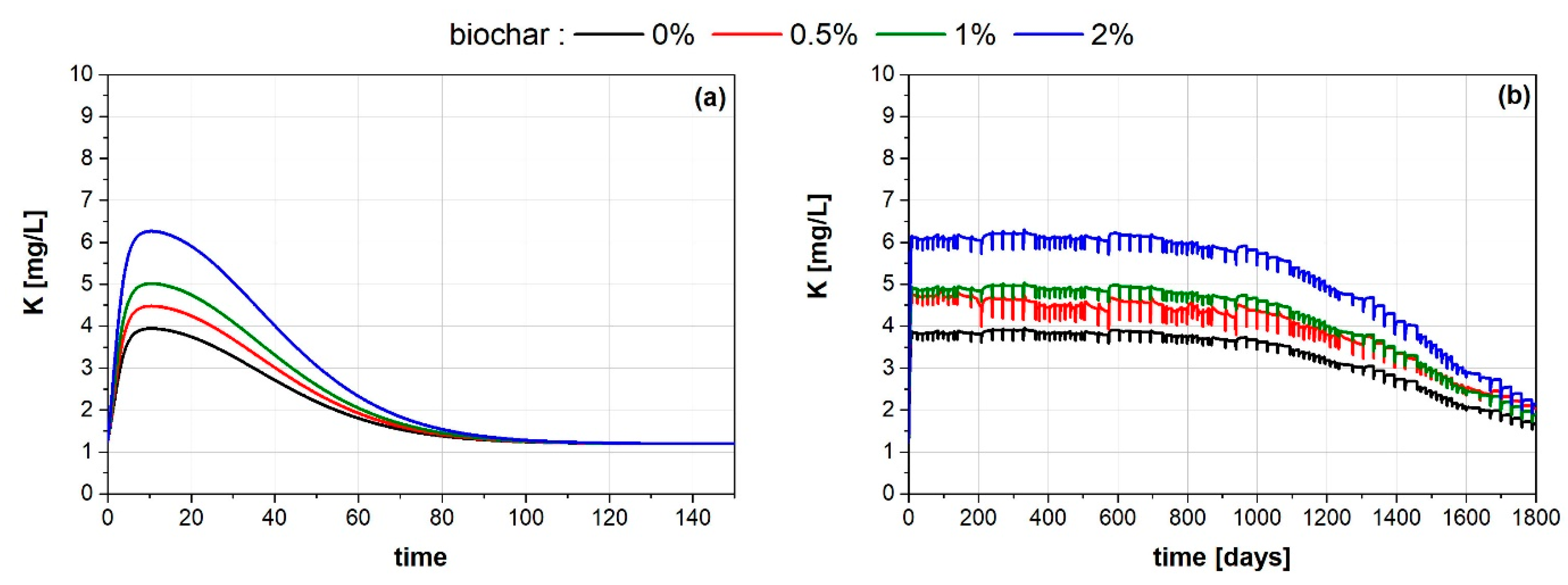
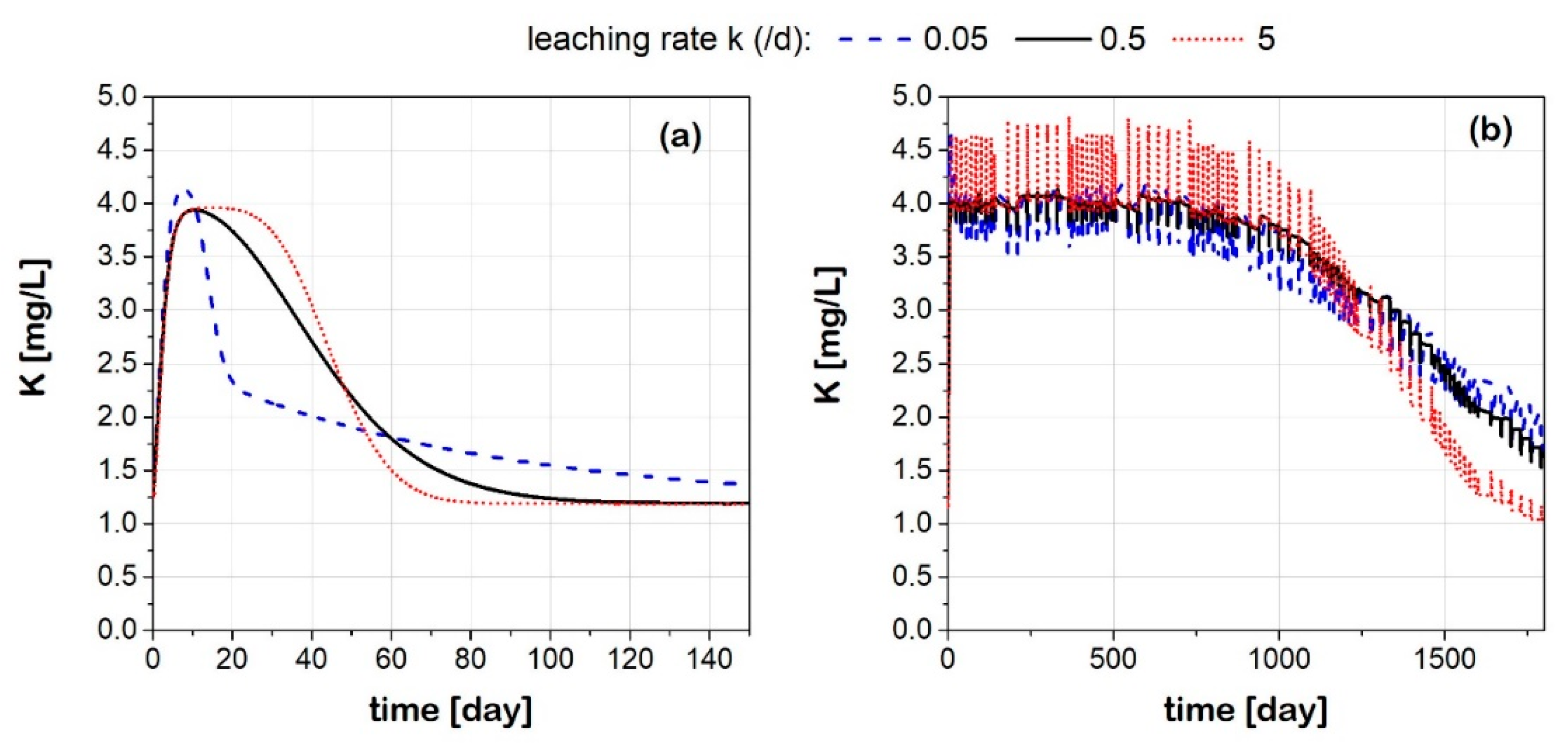
| Parameter | Value * |
|---|---|
| Sand (%) | 44.8 |
| Silt (%) | 29.6 |
| Clay (%) | 25.6 |
| Soil Texture | Loam |
| pH of soil/biochar | 7.07/10.3 |
| Electrical conductivity (mS cm−1) of soil/biochar | 0.38/7.56 |
| ESP (%) of soil/biochar | 1.13/28.0 |
| Organic matter (humified) (%) | 2.12 |
| Organic carbon (%) | 1.06 |
| CaCO3 equivalent (%) | 0.48 |
| Cation exchange capacity (cmol kg−1) | 18.5 |
| Wilting point at 15 atm (% w/w) | 24.8 |
| Field capacity at 0.3 atm (% w/w) | 33.8 |
| Bulk density (g cm−3) | 1.63 |
| Biochar Fraction in Soils | K | Na | Ca | Mg |
|---|---|---|---|---|
| 0% | 159 | 48 | 470 | 224 |
| 0.5% | 196 | 52 | 472 | 223 |
| 1% | 232 | 57 | 473 | 222 |
| 2% | 306 | 66 | 477 | 221 |
| Biochar | 7500 | 930 | 818 | 67 |
| Parameter | Value | Parameter | Value |
|---|---|---|---|
| pH | 7.49 | Na (mg L−1) | 83.6 |
| Temperature (°C) | 22.2 | K (mg L−1) | 1.2 |
| Electrical Conductivity (mS cm−1) | 1.229 | Ca (mg L−1) | 139.2 |
| Cl (mg L−1) | 192.9 | Mg (mg L−1) | 27.2 |
| HCO3 (mg L−1) | 279.7 | NO3 (mg L−1) | 122.7 |
| SO4 (mg L−1) | 46.7 | NH4 (mg L−1) | 0.2 |
| Parameter | Value |
|---|---|
| Residual soil water content, θr | 0.0616 |
| Saturated soil water content, θs | 0.3668 |
| Parameter a in the soil water retention function [cm−1] | 0.0174 |
| Parameter n in the soil water retention function | 1.3268 |
| Saturated hydraulic conductivity, Ks [cm d−1] | 10 |
| Pore-connectivity parameter, λ | 0.5 |
Disclaimer/Publisher’s Note: The statements, opinions and data contained in all publications are solely those of the individual author(s) and contributor(s) and not of MDPI and/or the editor(s). MDPI and/or the editor(s) disclaim responsibility for any injury to people or property resulting from any ideas, methods, instructions or products referred to in the content. |
© 2023 by the authors. Licensee MDPI, Basel, Switzerland. This article is an open access article distributed under the terms and conditions of the Creative Commons Attribution (CC BY) license (https://creativecommons.org/licenses/by/4.0/).
Share and Cite
Doulgeris, C.; Kypritidou, Z.; Kinigopoulou, V.; Hatzigiannakis, E. Simulation of Potassium Availability in the Application of Biochar in Agricultural Soil. Agronomy 2023, 13, 784. https://doi.org/10.3390/agronomy13030784
Doulgeris C, Kypritidou Z, Kinigopoulou V, Hatzigiannakis E. Simulation of Potassium Availability in the Application of Biochar in Agricultural Soil. Agronomy. 2023; 13(3):784. https://doi.org/10.3390/agronomy13030784
Chicago/Turabian StyleDoulgeris, Charalampos, Zacharenia Kypritidou, Vasiliki Kinigopoulou, and Evangelos Hatzigiannakis. 2023. "Simulation of Potassium Availability in the Application of Biochar in Agricultural Soil" Agronomy 13, no. 3: 784. https://doi.org/10.3390/agronomy13030784
APA StyleDoulgeris, C., Kypritidou, Z., Kinigopoulou, V., & Hatzigiannakis, E. (2023). Simulation of Potassium Availability in the Application of Biochar in Agricultural Soil. Agronomy, 13(3), 784. https://doi.org/10.3390/agronomy13030784









